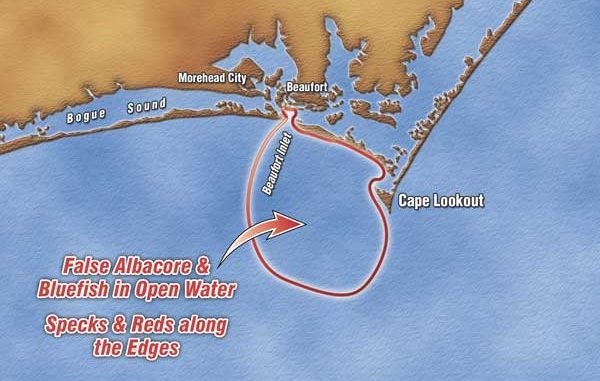
When March winds turn wave tops to sea spray, anglers can pick and choose between four types of hot fishing at Cape Lookout.
It was a typical day for a usually tepid fishing month — not the dead of winter but not quite spring, as a northeast wind bore down on the North Carolina coast.
The thermometer reading was in the low 50s, but the wind-chill factor made it feel much colder to tiny patches of exposed anglers’ noses, cheeks and hands. Rainwear with sweatshirts worn underneath was the uniform of the day.
Nevertheless, Capt. Dave Dietzler of Cape Lookout Charters headed out in the boxy 21-foot boat he had cast in rough fiberglass from one of the old Williscraft Boatworks molds. The boat was designed as a commercial fisherman’s craft for fishing nets and crab pots. The bow and stern were as flat as the bottom, so it wasn’t the most seaworthy boat to challenge the rippling briny blue.
However, where Dietzler fishes that deletes the option of spending the day inside beside a warm fire, nibbling on snacks and watching college basketball games on the television. Instead with this guide, there’s plenty of saltwater fishing action to be sampled from a variety of species.
“At Cape Lookout we like those northeast winds,” Dietzler said. “Shackleford Banks and Cape Lookout block the wind, and it’s calm and cozy in the lee.
“Lots of fish are (available), and you never know for sure what you’re going to come across any given day.
“In March we cast for false albacore, bluefish, speckled trout and red drum. What you catch depends on what lures you’re using and where you look, as well as which of those fish are here.”
As Dietzler’s boat approached the Cape Lookout Lighthouse, dozens of boats came into view. They were anchored in two rows with one on each side of the Cape’s famous rock jetty.
Surf anglers also fish from the beach at South Core Island, although the ferry service is closed from the first weekend of December to mid-March each year.
“Some people park their boats on the mainland of the island and walk to the beach,” Dietzler said. “They put on chest waders, walk out into the surf and cast spoons, jigs and hard-plastic lures to catch red drum and speckled trout.”
Dietzler’s brother, Ed Dietzler, accompanied him during this trip. He had come for a visit from their boyhood haunts in the Keystone State and was about to witness what had excited his brother for years about Cape Lookout fishing.
“I fish back home in Pennsylvania,” Ed Dietzler said, “but I really like fishing with Dave because we sure don’t have any fish like he catches.”
At the point of Cape Lookout, waves rolled across the sand bar, similar to a herd of roaming gray elephants, only their backs showing as they moved toward the beach. Sea spray wafted above the waves like smoke billowing from a wild fire. Inside the smoke plumes, flocks of sea birds seemed like swirling ashes as they circled and swooped down to spear baitfish.
“False albacore and bluefish are definitely in that area,” Dietzler said. “But we’ll stay out of the smoking water in this small boat. Let’s anchor and join the crowd fishing the rock jetty.”
The rock jetty runs perpendicular to the shoreline and was built to stabilize deeper water to the south of Cape Lookout. The man-made jetty attracts many species of fish, and anglers long ago discovered how hot this place can be, even during the most marginal conditions.
“Everyone hears stories of how good the speckled trout fishing has been,” Dietzler said. “But what they don’t realize is that out of 100 boats, maybe 10 or fewer of them will really get into the speckled trout.
“There are certain breaks in the rocks that hold the fish, and individual rocks that produce fish the best. But most of the rocks and pockets between them are ‘iffy’ and may or may not hold fish any given day.
“You want to find a rock that has deep water near it. Most of them have sand covering their bases nearly to the waterline. Having fast water flowing around rocks is always a plus. The fish hold in the deep holes and eddies created at the down-current sides of the rocks.”
Dietzler pitched out a standard fluke anchor at the ocean side of a rock. The tide was falling, so the boat’s bow turned into the current to face the jetty. Waves off the ocean washed against the stern and gunwale, creating a rock-and-roll motion that made it difficult to stand up without holding onto the console. Sometimes the anglers simply sat down to make casts.
At first, they cast MirrOlures to the rocks with no takers, so Dietzler began switching lures, using what he calls his “Cape Lookout Classic,” a combination of a ¼-ounce red lead jighead and a green twisty-tailed grub trailer.
It wasn’t long before a speckled trout smacked his jig, but the fish was too small to keep, so the guide tossed it back into the dark water.
“I’ve been watching the other boats, and those (anglers) landing fish are catching little specks,” he said. “I think we should switch to try for red drum.”
Behind the boat, a flock of sea birds chased a school of baitfish that had been forced to the surface by false albacore. Dietzler made a fast cast with a red jighead trailing a white split-tail fluke-style jerkbait and immediately hooked and landed a false albacore. The battle took several minutes and resulted in a supply of natural bait.
“It’s a nice one,” Dietzler said. “He’ll make some good drum bait.”
Deftly slicing off the shiny belly of the Fat Albert, Dietzler discarded the rest of the fish, making the gulls happy as they picked the remains. Cutting a strip of the belly meat, he replaced the artificial trailer with the natural bait.
His first cast to the jetty with the natural bait resulted in a taker. A red drum put up a strong fight against Dietzler’s light spinning tackle before coming to rest in a landing net. Repeated casts with the same jig-and-bait combo brought identical results.
“We could sit here and catch these little redfish all day,” Dietzler said. “But I think a better bet would be to chase some more false albacore.”
Pulling up the anchor, he navigated around the fleet of anchored boats and turned toward the shoreline. Flocks of birds were visible everywhere. They would appear for a few minutes, diving at false albacore and bluefish schools chasing baitfish to the surface, then they disbursed, flying fast in different directions to search for another meal ticket.
“Every now and then you can see them hovering like they’re about to dive,” Dietzler said. “They can see way down into the water and are watching a school that’s about to come to the top. If you can get there before they come up, you can be in time to make a few casts before they go down again. Otherwise, you try to get in an area where they appear to be concentrated.
“You see lots of boats running from bird flock to bird flock. But that’s likely to make the fish scatter or stay down deep. I’d rather get in a good spot where there are lots of birds and lot of fish and wait for them to come up.”
Dietzler circled an area 100 yards off the beach as his brother and a guest watched for birds in different directions.
“When you’re idling along, it pays to have a lure trolling behind you,” Ed Dietzler said. “You never know when it will run over a fish.”
A school of false albacore became visible against the sand, rising up in a wave against the beach. The baitfish they were feeding on flickered brightly against the tan sand. While the three anglers watched the school of Fat Alberts, the drag on Ed Dietzler’s reel screeched.
“See, trolling works,” he said. “This feels like a nice fish.”
Another albacore was following the fish Ed Dietzler was fighting, so his brother made a quick cast with the white fluke lure and the second fish struck. The brothers fought their fish to exhaustion using light spinning rigs, and the battles burned several minutes and a couple of dozen fast runs before the fish tired enough to net.
As the fish were brought aboard, they disgorged silverside minnows across the deck, and Ed Dietzler was torpedoed by ejected baitfish.
“You can see what they’re eating,” his brother said, laughing. “If they get finicky, you can match the lure to the baitfish they’re feeding on. But most of the time, if you cast something shiny or white and reel it fast, a false albacore or bluefish is going to hit it. You can’t reel anything so fast a false albacore or bluefish can’t catch it.”
Moving to another raucous flock of sea birds and churning school of fish, the veteran guide made a cast, but the wind was howling hard enough to blow the lure off course 20 feet where it landed behind the school.
Dietzler allowed for more windage and landed a second cast in front of the school. A sea bird made a dive at the fluke and missed, but a bluefish struck, and the hook stuck.
“Bluefish are not at all picky about what they eat,” Dietzler said. “But sometimes they can be finicky about the size. I usually catch them with the same lures I use for false albacore. But I might switch to spoons or speck jigs with bucktails because they’re more durable than soft-plastic lures. A bluefish will nip off the tail of a soft-plastic trailer and miss the hook; they can go through a bag of your lures in a hurry.”
So many bluefish and false albacore smacked lures it was easy to forget about red drum and speckled trout fishing. Ignoring the scouting sea birds was almost impossible as they gave away the presence of the fast-moving fish schools.
Dietzler headed back along Shackleford Banks toward Beaufort Inlet. Using the banks as a windbreak, he kept the small boat on plane without so much as a drop of water splashing over the bow. He slowed while crossing the inlet, watching for more sea birds then headed across the inlet to Fort Macon.
“The Fort Macon rock jetty is another good place to fish for specks,” he said. “They’re either there or they’re not. Today there aren’t any boats, so I doubt there are any fish. Besides, the wind’s coming across the inlet, and it’s a bit rough.”
Dietzler tried another spot near the inlet he called Bulkhead Channel. Anchoring beside the bulkhead, the anglers made several casts, using 52M series MirrOlures to try to entice big specks lurking in the slack water behind the pilings.
“They were here yesterday,” Dietzler said. “We had several specks and two of them weighed more than 5 pounds. But today it’s too windy to reach the bulkheads with a cast. Too much wind also puts a big belly in your line, and it’s too hard to feel the strike and set the hook.”
Indeed, the boat was anchored downwind of the bulkhead, and the March wind was howling from the bulkhead toward the boat. It nipped at the angler’s faces and tried its best to rip stocking caps off their heads. Despite all the effort an arm could muster, it was a feat just to cast to the bulkhead.
“Has everyone had enough fun for the day?” Dietzler said. “I think we should leave the specks for another day.”
Discretion is the better part of valor, and everyone had caught plenty of fish, so the decision to finish the trip, head back in and get warm and dry was an easy one.
While the speckled trout and redfish had made a lackluster showing, bluefish and false albacore had bit with a vengeance in the open water.
Fortunately for March anglers, something’s always biting near Cape Lookout, even during tough early March fishing conditions.
Anglers are lucky to be able to pick and choose from a four-species smorgasbord this time of year when the wind whips the water, and the sea spray comes smoking across the Cape.



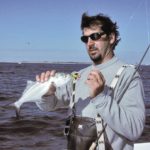
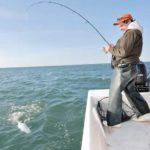
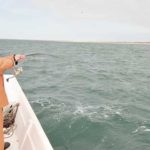
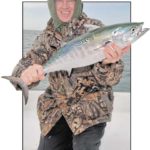
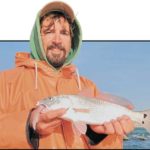

Be the first to comment